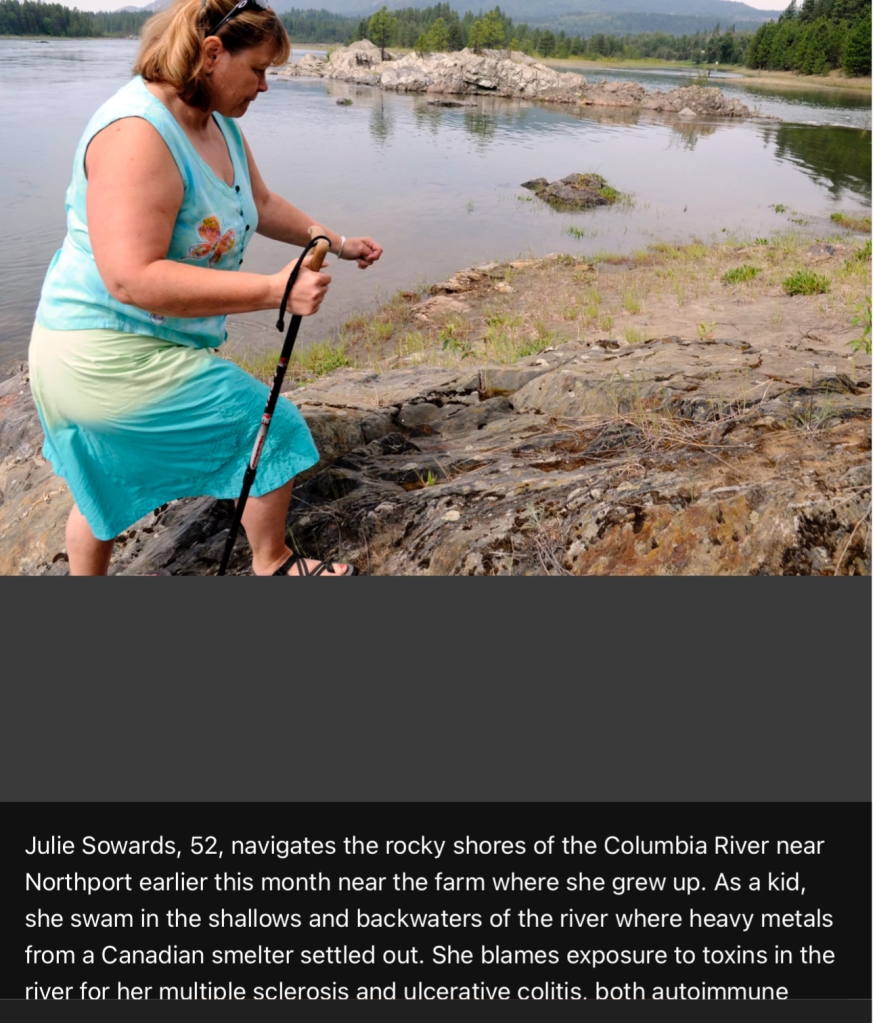Teck, a Canadian smelter, tries to rewrite U.S. Superfund laws to avoid liability
by: Jamie Paparich, Feb. 24, 2016
Teck smelter, one of the world’s largest lead and zinc smelting plants, is located in Trail, B.C. Canada.
Since 1906 the Canadian smelter’s processing of ore creates discharge, or waste, that contain dangerous heavy metal toxins. The smelter released these toxins into Washington state’s environment in two ways; water and air.
Teck, located just 3 miles upriver from the Washington state border, denied any wrong doing for decades. They reasoned that since they were operating in Canada they were not liable under U.S. CERCLA (Superfund) laws.
Therefore, Teck felt is was Washington state’s responsibility to conduct the studies and eventual clean-up of the mess they had made. After a decade long battle with the EPA in court, Teck ran out of options in 2012 and admitted to dumping their toxic discharge directly into the Columbia River for over a century.
Dave Godlewski, the vice-president of environment and public affairs for Teck, stated; “Trail discharged solid effluents, or slag, and liquid effluent into the Columbia River that came to rest in Washington state, and from that material, hazardous materials….were released into the environment….”
Dave Godlewski goes on to say; “We’ve not talked about the amount of the release. We’ve not talked about the impacts of those releases. We’ve just agreed that there has been a release in the U.S.”
Teck may not want to talk about the amount, but the research conducted on the Upper Columbia River site by The EPA, the Washington Department of Ecology, and Teck themselves has shown that between 1906 and 1995 they released approximately 9.8 million tons of slag into the river. This slag contained 1,314,00 tons of Lead, 4,434,750 tons of Cadmium, 302,250 tons of Mercury, and 525,600,000 tons of Zinc.
“The estimated 9.8 million tons (of slag) that (Teck) has dumped into the river is equivalent to a dump truck emptying 19 tons every hour for 60 years.”
Karen Dorn Steel, The Spokesman Review (2003).
Teck has been conducting environmental studies since 2012, with oversight from the EPA. They claim they accept responsibility for their past actions, and want to make things right.
However, they are currently trying to duck more responsibility by appealing a recent federal district court judge’s ruling that Teck may also be responsible for the contamination caused by their air emissions, not just from the toxins they discharged into our water and land. Teck claims that under the CERCLA (Superfund) law the word “disposal” is defined as “require(ing) that waste be first placed into or on land or water…”, not air. Therefore, their air emissions don’t count.
To bring this situation into perspective it is important to understand the amount of toxins Teck released, and the damage it caused. Between 1921 – 2005 – Teck released; 38,465 tons of Zinc, 22,688 tons of Lead, 1,225 tons of Arsenic, 1,103 tons of Cadmium, and 97 tons of Mercury through their air emissions.
The amount of sulfur dioxide Teck was releasing in the air in 1933 reached such damaging levels that Northport farmers sued Teck (then Trail Smelter) for the damage the air emissions had caused to their livestock and crops, greatly impacting their annual earnings. The air was so polluted crops were visibly burned and the pollutants were killing the animals via the food they ate and the inhalation of the air. The burn line on the trees was still visible well into the 1980’s. Journals a family in Northport kept, written by a family member at the time, summarized that the air was so bad barbwire fences were disintegrating, paint on cars was peeling off, and animals were falling over dead. In 1941, after a drawn out process, the International Joint Commission agreed Teck was liable and ordered them to pay the farmers $34,807.00.
Several area modeling studies have been conducted of the area, showing the massive damage the air emissions have caused. To view Click here.
Teck thinks it can escape responsibility for it’s air emissions by manipulating the wording Congress used when drafting CERCLA. Teck intentionally emitted toxins into the air, knowing very well those toxins would eventually be deposited on our land and water. The 1933 Trail Smelter arbitration, mentioned above, is legal proof they were very aware of this, as was Canada. Yet recently Canada has said they agree with Teck’s interpretation of the U.S. law, claiming that if Teck is penalized for their air emission’s it would violate Canada’s sovereign authority, because the emissions took place on Canadian soil.
Apparently Canada does not think anything exists beyond their borders, or at least they are not liable for anything they do to these places. Out of sight, out of mind?
The health impacts suffered by Northport, WA residents, from decades of exposure to the Canadian smelter’s toxins, is a liability to their quality of life. Yet they live with this responsibility everyday of their lives. Never out of sight, never out of mind.
The hearing on Teck’s air emission appeal is scheduled for April, 2016.




Leave a Reply/Comment